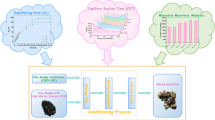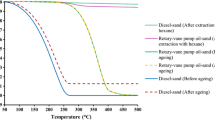Abstract
Oil sludge is the primary pollutant produced by the petroleum industry, which is characterized by large quantities, difficult disposal, and high toxicity. Improper treatment of oil sludge will pose a severe threat to the human living environment. Self-sustaining treatment for active remediation (STAR) technology has a specific potential for treating oil sludge, with low energy consumption, short remediation time, and high removal efficiency. Given the low smoldering porosity, poor air permeability, and poor repair effect of oil sludge, this paper considered coarse river sand as the porous medium, built a smoldering reaction device, conducted a comparative study on smoldering experiments of oil sludge with and without river sand, and studied the key factors affecting smoldering of oil sludge. The study shows that the repair effect is greatly improved by adding river sand, increasing the pore, and improving air permeability, and the total petroleum hydrocarbon removal rate reaches more than 98%, which meets the requirements of oil sludge treatment. When the mass ratio of oil sludge to river sand (sludge–sand ratio) is 2:1, the flow velocity is 5.39 cm/s, and the particle size of the medium is 2–4 mm. In addition, the best conditions for smoldering occur. The average peak temperature, average propagation speed, and average removal efficiency are relatively high. The peak temperature occurs in a short time; the heating time is also short, and the heat loss is low. Moreover, the generation of toxic and harmful gases is reduced, and secondary pollution is hindered. The experiment indicates that the porous media play a crucial role in the smoldering combustion of oil sludge.









Similar content being viewed by others
Availability of data and materials
The datasets used and analyzed during the current study are available from the corresponding author on reasonable request.
References
Al-Zahrani SM, Putra MD (2013) Used lubricating oil regeneration by various solvent extraction techniques. J Ind Eng Chem 19(2):536–539. https://doi.org/10.1016/j.jiec.2012.09.007
Butt TE, Lockley E, Oduyemi KOK (2008) Risk assessment of landfill disposal sites–state of the art. Waste Manage 28(6):952–964. https://doi.org/10.1016/j.wasman.2007.05.012
Chao CYH, Wang JH (2001) Transition from smoldering to flaming combustion of horizontally oriented flexible polyurethane foam with natural convection. Combust Flame 127(4):2252–2264. https://doi.org/10.1016/S0010-2180(01)00326-1
Da Silva LJ, Alves FC, de França FP (2012) A review of the technological solutions for the treatment of oily sludges from petroleum refineries. Waste Manage Res 30(10):1016–1030. https://doi.org/10.1177/0734242X12448517
Duchesne AL, Brown JK, Patch DJ, Major D, Weber KP, Gerhard JI (2020) Remediation of PFAS-contaminated soil and granular activated carbon by smoldering combustion. Environ Sci Technol 54(19):12631–12640. https://doi.org/10.1021/acs.est.0c03058
Fabris I, Cormier D, Gerhard JI, Bartczak T, Kortschot M, Torero JL, Cheng YL (2017) Continuous, self-sustaining smouldering destruction of simulated faeces. Fuel 190:58–66. https://doi.org/10.1016/j.fuel.2016.11.014
Gan Z, Zhao C, Li Y, Chen G, Song Z, Zhang Z, Ran W (2022) Experimental investigation on smoldering combustion for oil sludge treatment: influence of key parameters and product analysis. Fuel 316:123354. https://doi.org/10.1016/j.fuel.2022.123354
Huang FT (1983) Physical and chemical properties, composition and characteristics of crude oil from Daqing Oilfield. Journal of Daqing Pet Ins 02:54–66
Hu G, Li J, Zeng G (2013) Recent development in the treatment of oily sludge from petroleum industry: a review. J Hazard Mater 261:470–490. https://doi.org/10.1016/j.jhazmat.2013.07.069
Jean DS, Lee DJ, Wu JCS (1999) Separation of oil from oily sludge by freezing and thawing. Water Res 33(7):1756–1759. https://doi.org/10.1016/S0043-1354(99)00005-6
Jia A, Hong M, Wei T, Jia T, Zhang S (2022) Remediation of coal tar–contaminated soil by smoldering combustion using vegetable oils as supplemental fuel. J Environ Eng 148(9):04022054. https://doi.org/10.1061/(ASCE)EE.1943-7870.0002030
Karamalidis AK, Voudrias EA (2007) Cement-based stabilization/solidification of oil refinery sludge: leaching behavior of alkanes and PAHs. J Hazard Mater 148(1-2):122–135. https://doi.org/10.1016/j.jhazmat.2007.02.032
Kinsman L, Torero JL, Gerhard JI (2017) Organic liquid mobility induced by smoldering remediation. J Hazard Mater 325:101–112. https://doi.org/10.1016/j.jhazmat.2016.11.049
Liang J, Zhao L, Hou W (2017) Solid effect in chemical cleaning treatment of oily sludge. Colloids Surf A 522:38–42. https://doi.org/10.1016/j.colsurfa.2017.02.038
Lin Q, Hong M (2022) The effect of sand fractional wettability on SDBS-enhanced PCE immiscible mobilization in porous media. Environ Sci Pollut Res 1-14. https://doi.org/10.1007/s11356-022-23570-z
Liu J, Jiang X, Zhou L, Han X, Cui Z (2009) Pyrolysis treatment of oil sludge and model-free kinetics analysis. J Hazard Mater 161(2-3):1208–1215. https://doi.org/10.1016/j.jhazmat.2008.04.072
McCarter RJ (1977) Smoldering combustion of cotton and rayon. J Consum Prod Flammabl 4(4):346–358 http://worldcat.org/issn/03621677
Mirghaffari N (2017) Treatment and recycling of oily sludges produced in the petroleum industry. In: In 2017 International Conference on Environmental Impacts of the Oil and Gas Industries: Kurdistan Region of Iraq as a Case Study (EIOGI). IEEE, pp 1–2. https://doi.org/10.1109/EIOGI.2017.8267638
Mrayyan B, Battikhi MN (2005) Biodegradation of total organic carbons (TOC) in Jordanian petroleum sludge. J Hazard Mater 120(1-3):127–134. https://doi.org/10.1016/j.jhazmat.2004.12.033
Moussa NA, Toong TY, Garris CA (1977) Mechanism of smoldering of cellulosic materials. In Symposium (International) on Combustion 16(1):1447–1457. https://doi.org/10.1016/S0082-0784(77)80427-X
Muramatsu M, Umemura S, Okada T (1979) A mathematical model of evaporation-pyrolysis processes inside a naturally smoldering cigarette. Combust Flame 36:245–262. https://doi.org/10.1016/0010-2180(79)90063-4
Pironi P, Switzer C, Gerhard JI, Rein G, Torero JL (2011) Self-sustaining smoldering combustion for NAPL remediation: laboratory evaluation of process sensitivity to key parameters. Environ sci Technol 45(7):2980–2986. https://doi.org/10.1021/es102969z
Pironi P, Switzer C, Rein G, Fuentes A, Gerhard JI, Torero JL (2009) Small-scale forward smouldering experiments for remediation of coal tar in inert media. P Combust Inst 32(2):1957–1964. https://doi.org/10.1016/j.proci.2008.06.184
Ramaswamy B, Kar DD, De S (2007) A study on recovery of oil from sludge containing oil using froth flotation. J Environ Manage 85(1):150–154. https://doi.org/10.1016/j.jenvman.2006.08.009
Rashwan TL, Gerhard JI, Grant GP (2016) Application of self-sustaining smouldering combustion for the destruction of wastewater biosolids. Waste Manage 50:201–212. https://doi.org/10.1016/j.wasman.2016.01.037
Rashwan TL, Torero JL, Gerhard JI (2021) Heat losses in a smouldering system: The key role of non-uniform air flux. Combust Flame 227:309–321. https://doi.org/10.1016/j.combustflame.2020.12.050
Ren H, Bi Y, Liu F, Zhang C, Wei N, Fan L, Zhou R (2022) Removal of ofloxacin from wastewater by chloride electrolyte electro-oxidation: analysis of the role of active chlorine and operating costs. Sci Total Environ 850:157963. https://doi.org/10.1016/j.scitotenv.2022.157963
Scholes GC, Gerhard JI, Grant GP, Major DW, Vidumsky JE, Switzer C, Torero JL (2015) Smoldering remediation of coal-tar-contaminated soil: pilot field tests of STAR. Environ Sci Technol 49(24):14334–14342. https://doi.org/10.1021/acs.est.5b03177
Song Z, He T, Li M, Wu D, You F (2022) Self-sustaining smoldering as a novel disposal approach for food waste with high moisture content. Fuel Process Technol 228:107144. https://doi.org/10.1016/j.fuproc.2021.107144
Switzer C, Pironi P, Gerhard JI, Rein G, Torero JL (2009) Self-sustaining smoldering combustion: a novel remediation process for non-aqueous-phase liquids in porous media. Environ Sci Technol 43(15):5871–5877. https://doi.org/10.1021/es803483s
Switzer C, Pironi P, Gerhard JI, Rein G, Torero JL (2014) Volumetric scale-up of smouldering remediation of contaminated materials. J Hazard Mater 268:51–60. https://doi.org/10.1016/j.jhazmat.2013.11.053
Torero JL, Gerhard JI, Martins MF, Zanoni MA, Rashwan TL, Brown JK (2020) Processes defining smouldering combustion: integrated review and synthesis. Prog Energy Combust Sci 81:100869. https://doi.org/10.1016/j.pecs.2020.100869
Watts AC, Kobziar LN (2013) Smoldering combustion and ground fires: ecological effects and multi-scale significance. Fire Ecol 9:124–132. https://doi.org/10.4996/fireecology.0901124
Wei T, Hong M, Liu L (2018) Study on the removal effect and influencing factors of nitrobenzene reduction by iron carbonate precipitates. Environ Sci Pollut Res 25:27112–27121. https://doi.org/10.1007/s11356-018-2621-y
Wu Lei (2017) Research and application of oily sludge treatment technology in Daqing oilfield. Dissertation, Harbin University of Technology (in chinese)
Yang Gaoxuan (2021) Study on smoldering treatment technology of oily sludge . Dissertation, Dalian University of Technology (in chinese)
Yang G, Zhan J (2022) Study on smoldering treatment of oily sludge in Huabei Oilfield. Applied Chemical Engineering 51(02):317-321 (in chinese). https://doi.org/10.16581/j.cnki.issn1671-3206.20211119.002
Yi L, Dong L (2011) Experimental Study of Upward Forward Smoldering Combustion. Procedia Eng 11:196–204. https://doi.org/10.1016/j.proeng.2011.04.647
Yermán L, Hadden RM, Carrascal J, Fabris I, Cormier D, Torero JL, Cheng YL (2015) Smouldering combustion as a treatment technology for faeces: exploring the parameter space. Fuel 147:108–116. https://doi.org/10.1016/j.fuel.2015.01.055
Yermán L, Wall H, Torero JL, Gerhard JI, Cheng YL (2016) Smoldering combustion as a treatment technology for feces: sensitivity to key parameters. Combust Sci Technol 188(6):968-981. https://doi.org/10.1080/00102202.2015.1136299
Yermán L, Wall H, Torero JL (2017) Experimental investigation on the destruction rates of organic waste with high moisture content by means of self-sustained smoldering combustion. P Combust Inst 36(3):4419–4426. https://doi.org/10.1016/j.proci.2016.07.052
Zanoni MA, Torero JL, Gerhard JI (2020) Experimental and numerical investigation of weak, self-sustained conditions in engineered smouldering combustion. Combust Flame 222:27–35. https://doi.org/10.1016/j.combustflame.2020.08.020
Zhang J (2012) Treatment of refinery oily sludge using ultrasound, bio-surfactant, and advanced oxidation processes (Doctoral dissertation, University of Northern British Columbia).
Zhao C, Li Y, Gan Z, Nie M (2021) Method of smoldering combustion for refinery oil sludge treatment. J Hazard Mater 409:124995. https://doi.org/10.1016/j.jhazmat.2020.124995
Zhou L, Jiang X, Liu J (2009) Characteristics of oily sludge combustion in circulating fluidized beds. J Hazard Mater 170(1):175–179. https://doi.org/10.1016/j.jhazmat.2009.04.109
Funding
This work was supported by the National Natural Science Foundation of China (number: 42177052).
Author information
Authors and Affiliations
Contributions
All authors contributed to the study conception and design. Material preparation, data collection and analysis, and the first draft of the manuscript were completed by Shuai Zhang. The entire experiment was funded by Mei Hong. Experimental design guidance and literature collection were completed by Aiyuan Jia. All authors commented on the previous versions of the manuscript. All authors read and approved the final manuscript.
Corresponding author
Ethics declarations
Ethics approval and consent to participate
Not applicable
Consent for publication
Not applicable
Competing interests
The authors declare no competing interests.
Additional information
Responsible Editor: Ta Yeong Wu
Publisher’s note
Springer Nature remains neutral with regard to jurisdictional claims in published maps and institutional affiliations.
Rights and permissions
Springer Nature or its licensor (e.g. a society or other partner) holds exclusive rights to this article under a publishing agreement with the author(s) or other rightsholder(s); author self-archiving of the accepted manuscript version of this article is solely governed by the terms of such publishing agreement and applicable law.
About this article
Cite this article
Zhang, S., Hong, M. & Jia, A. Feasibility study of porous media for treating oily sludge with self-sustaining treatment for active remediation technology. Environ Sci Pollut Res 30, 70131–70142 (2023). https://doi.org/10.1007/s11356-023-27196-7
Received:
Accepted:
Published:
Issue Date:
DOI: https://doi.org/10.1007/s11356-023-27196-7




